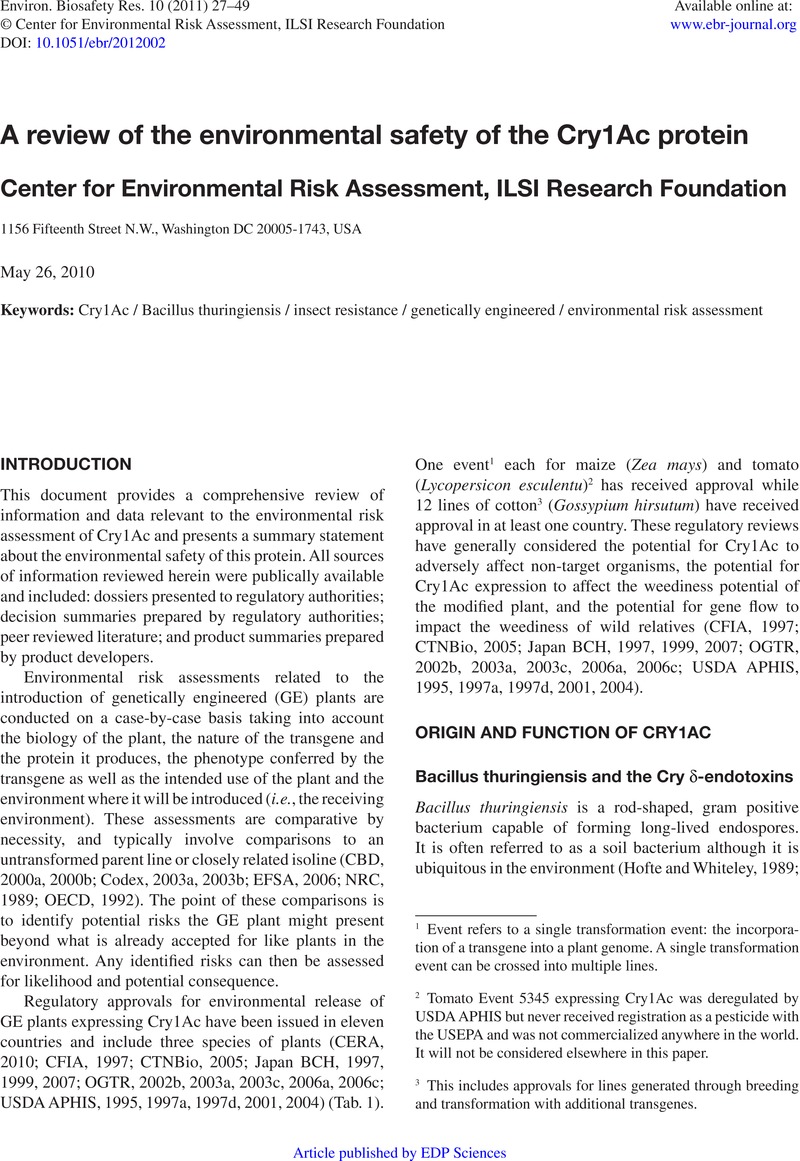Crossref Citations
This article has been cited by the following publications. This list is generated based on data provided by Crossref.
Roberts, Andrew
Devos, Yann
Raybould, Alan
Bigelow, Patrick
and
Gray, Alan
2014.
Environmental risk assessment of GE plants under low-exposure conditions.
Transgenic Research,
Vol. 23,
Issue. 6,
p.
971.
Tian, Jun-Ce
Yao, Ju
Long, Li-Ping
Romeis, Jörg
and
Shelton, Anthony M.
2015.
Bt crops benefit natural enemies to control non-target pests.
Scientific Reports,
Vol. 5,
Issue. 1,
Ullah, I.
Hagenbucher, S.
Álvarez‐Alfageme, F.
Ashfaq, M.
and
Romeis, J.
2015.
Target and non‐target effects of a spider venom toxin produced in transgenic cotton and tobacco plants.
Journal of Applied Entomology,
Vol. 139,
Issue. 5,
p.
321.
Torres-Martínez, Marilu
Rubio-Infante, Néstor
García-Hernández, Ana Lilia
Nava-Acosta, Raúl
Ilhuicatzi-Alvarado, Damaris
and
Moreno-Fierros, Leticia
2016.
Cry1Ac toxin induces macrophage activation via ERK1/2, JNK and p38 mitogen-activated protein kinases.
The International Journal of Biochemistry & Cell Biology,
Vol. 78,
Issue. ,
p.
106.
Eisenring, Michael
Romeis, Jörg
Naranjo, Steven E.
and
Meissle, Michael
2017.
Multitrophic Cry-protein flow in a dual-gene Bt-cotton field.
Agriculture, Ecosystems & Environment,
Vol. 247,
Issue. ,
p.
283.
Prodhan, Md. Zulfikar Haider
Shirale, Dattatray K.
Islam, Md. Zaherul
Hossain, Md. Jahangir
Paranjape, Vijay
and
Shelton, Anthony M.
2019.
Susceptibility of Field Populations of Eggplant Fruit and Shoot Borer (Leucinodes orbonalis Guenée) to Cry1Ac, the Protein Expressed in Bt Eggplant (Solanum melongena L.) in Bangladesh.
Insects,
Vol. 10,
Issue. 7,
p.
198.
Baranski, Rafal
Klimek-Chodacka, Magdalena
and
Lukasiewicz, Aneta
2019.
Approved genetically modified (GM) horticultural plants: A 25-year perspective.
Folia Horticulturae,
Vol. 31,
Issue. 1,
p.
3.
Paul, Sanjoy Kumar
Mahmud, Nur Uddin
and
Islam, Tofazzal
2022.
Bacilli in Agrobiotechnology.
p.
539.
Julian-Chávez, Brenda
Siqueiros-Cendón, Tania S.
Torres-Castillo, Jorge Ariel
Sinagawa-García, Sugey Ramona
Abraham-Juárez, María Jazmín
González-Barriga, Carmen Daniela
Rascón-Cruz, Quintín
Siañez-Estrada, Luis Ignacio
Arévalo-Gallegos, Sigifredo
and
Espinoza-Sánchez, Edward Alexander
2024.
Silencing ACE1 Gene with dsRNA of Different Lengths Impairs Larval Development in Leptinotarsa decemlineata.
Insects,
Vol. 15,
Issue. 12,
p.
1000.



